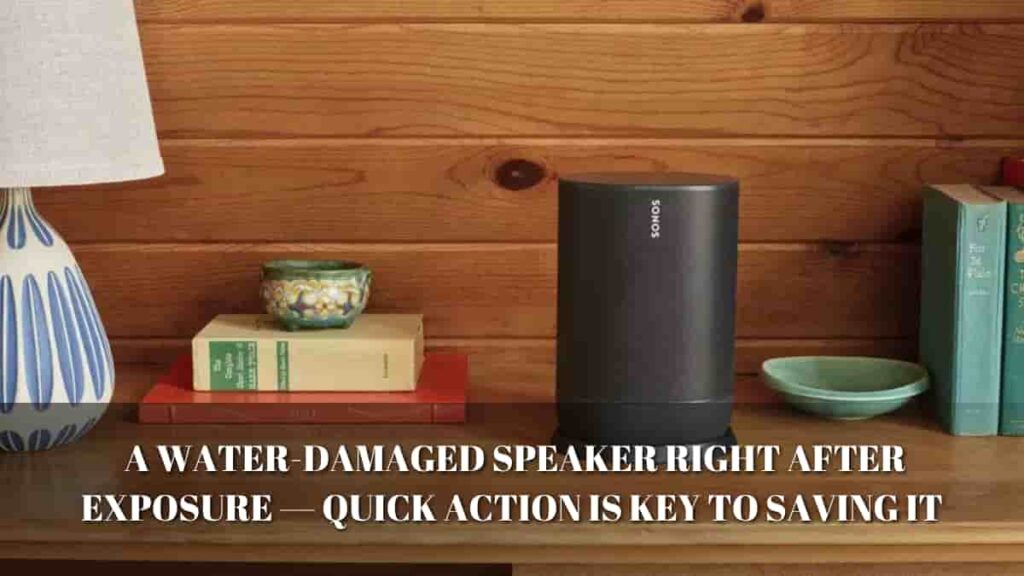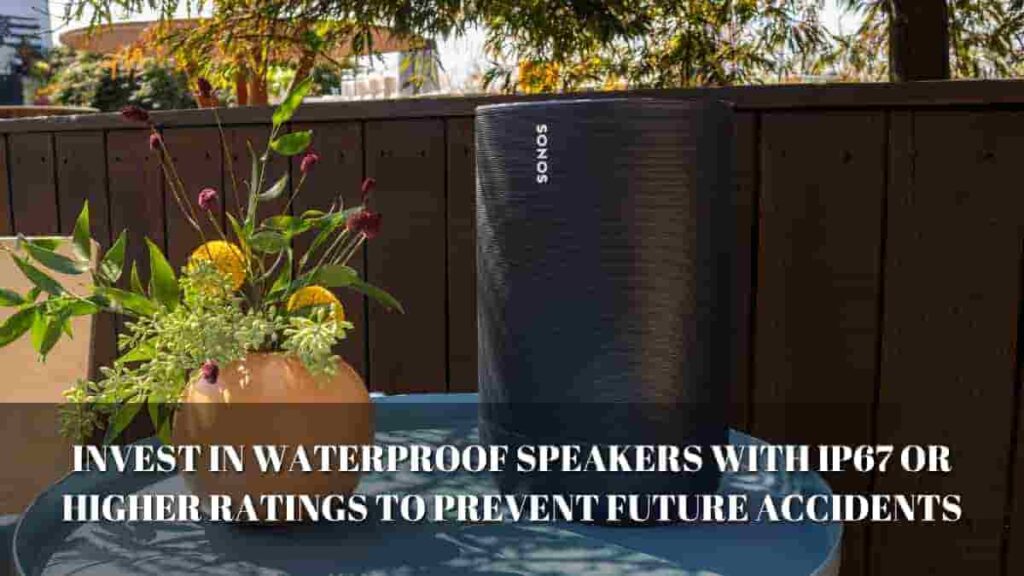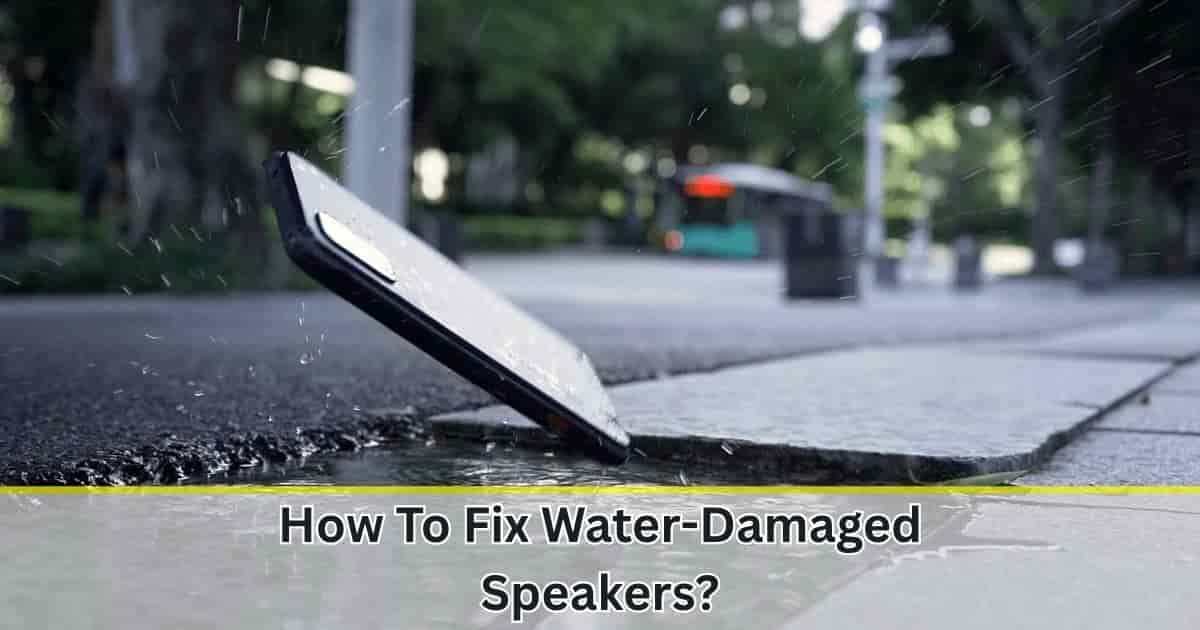Table of Contents
Water and electronics don’t mix; a statement every gadget user learns the difficult way. Water-damage speaker can destroy sound quality or completely stop your speaker from functioning whether you have inadvertently thrown your phone into the pool, spilt a drink on your Bluetooth speaker, or caught in the rain with your earbuds in. Not all hope is gone, sadly. It is really possible to repair a water-damaged speaker on your own if you move quickly and adhere to the right methods.
This thorough tutorial will take you step-by-step over everything you should know about rescuing a speaker from water damage. We will also investigate some often made errors to prevent, tools you could need, and when to get expert guidance from immediate actions to long-term solutions.
Understanding Water-Damaged Speakers
How Does Water Affect Speakers?
Speakers are made of delicate components like coils, cones, magnets, and membranes. When water enters the speaker housing, it can:
- Muffle the sound or distort audio
- Short-circuit internal electronics
- Corrode metal parts
- Affect diaphragm movement
- Leave moisture inside that causes long-term damage
Signs Your Speaker Has Water-Damage
- Muffled, crackling, or no sound
- Distortion at high volumes
- Random power-offs
- Physical moisture visible through grills
- Unresponsive controls
Step-by-Step Guide: How to Fix a Water-Damaged Speaker

Step 1: Turn Off the Speaker Immediately
As soon as you notice your speaker is wet or has fallen in water:
- Power it off right away.
- Disconnect from any power source or remove the battery (if possible).
- Unplug all cables.
Avoid pressing any buttons or trying to turn it on again. Doing so might short-circuit internal components.
Step 2: Dry the Outer Surface
Use a soft microfiber towel or lint-free cloth to gently wipe off water from:
- Speaker grills
- Ports
- Buttons
- Casing edges
Avoid shaking the speaker violently, as that may push water deeper inside.
Step 3: Remove Excess Water
To expel moisture from inside the speaker:
- Hold the speaker upright and gently tap or tilt it to encourage water drainage.
- For smartphones or devices with tiny speakers, use a clean cotton swab around the grill.
- For Bluetooth or box-style speakers, gently shake or pat them dry without applying force.
Step 4: Let It Air Dry (At Least 24-48 Hours)
Place the speaker in a dry, well-ventilated area:
- Position it so gravity helps drain trapped moisture (e.g., speaker grill facing down).
- Keep the speaker in a warm (not hot) room.
- Avoid direct sunlight or heaters that could warp internal parts.
Leave it undisturbed for at least 24–48 hours.
Step 5: Use Silica Gel or Uncooked Rice
For deeper drying:
- Place the speaker in a sealed container or bag.
- Surround it with silica gel packets (ideal) or uncooked rice (common alternative).
- Let it sit for 24–72 hours.
Tip: Silica gel is more effective than rice, as it doesn’t leave particles or dust behind.
Step 6: Check the Sound Using a Speaker Cleaner App
Once dry, test your speaker using a frequency sweep app or speaker cleaner tool. These apps play specific sounds to eject remaining water or clean clogged ports by vibrating the speaker membrane.
Popular apps include:
- Fix My Speaker (web-based)
- Speaker Cleaner (Android)
- Sonic (iOS)
Start with low volume and gradually increase it. If distortion continues, try repeating the drying process.
Step 7: Disassemble the Speaker (Advanced Step)
⚠️ Only recommended if:
- You’re tech-savvy or experienced with electronics
- The speaker is out of warranty
- Water is still trapped inside after basic drying
Tools You’ll Need:
- Precision screwdriver
- Tweezers
- Isopropyl alcohol (90% or higher)
- Soft brush
Steps:
- Open the speaker casing carefully.
- Disconnect the battery.
- Check for moisture, corrosion, or water spots.
- Use isopropyl alcohol to clean affected areas.
- Let the components dry fully.
- Reassemble and test.
Step 8: Test and Calibrate Sound Quality
Once the speaker turns on:
- Play different types of audio (music, voices, tones).
- Check for distortion, volume issues, and clarity.
- If only one side or channel isn’t working, internal damage may be localized.
You can also use equalizer apps or built-in settings to fine-tune the audio output.
Common Mistakes to Avoid
- Turning the device back on too soon: Can cause a short circuit.
- Using a hairdryer or oven: High heat damages sensitive components.
- Poking speaker grills with sharp objects: May tear the membrane.
- Skipping the drying phase: Even if it looks dry, internal moisture remains.
When to Seek Professional Help

Despite your best DIY efforts, some speakers may require expert care. Contact a technician if:
- The sound remains distorted or silent
- The battery won’t charge
- Buttons stop responding
- You see corrosion on metal contacts
- The device shows signs of internal damage after disassembly
For expensive or high-end devices (like Bose, JBL, or Apple HomePod), getting it serviced might be more cost-effective than risking further damage.
Preventing Future Water Damage
While accidents happen, here are a few tips to reduce the risk:
1. Use Waterproof Cases or Covers
Many brands offer rugged, waterproof casings or silicone sleeves for speakers.
2. Buy Waterproof or Water-Resistant Devices
Look for IP67 or IP68-rated speakers for use near water (beaches, pools, showers).
3. Avoid Charging in Moist Conditions
Never plug in a device when wet. Let it dry completely before charging.
4. Store in a Dry, Elevated Spot
Keep speakers away from kitchen sinks, bathtubs, or windowsills where water can drip.
Table: Quick Fix Summary
| Action | Details | Time Required |
| Power Off | Immediately shut down the speaker | Instant |
| Dry Surface | Use cloth to wipe external water | 5–10 minutes |
| Drain Moisture | Gently shake or tap speaker | 5 minutes |
| Air Dry | Place in ventilated area | 24–48 hours |
| Use Silica/Rice | Seal in bag for moisture absorption | 24–72 hours |
| Test with App | Use sound wave to eject water | 5–10 minutes |
| Disassemble (Optional) | Open and clean internals | 1–2 hours |
| Check Functionality | Play audio and calibrate | 10–15 minutes |
FAQs
Q1. What if only one side of my speaker works?
This often indicates partial water damage. Re-drying or disassembly may help. Check the audio balance settings too.
Q2. Can saltwater permanently damage a speaker?
Yes, salt accelerates corrosion. If your speaker is exposed to saltwater, rinse it with distilled water immediately before drying.
Q3. Will a speaker cleaner app fix hardware damage?
No, such apps only help eject residual water. They can’t repair burnt or corroded circuits.
Q4. Can I use a vacuum to suck out water?
Small, handheld vacuums may help, but be cautious of static electricity or internal damage.
Q5. My speaker sounds muffled even after drying. What now?
Check for trapped particles, test with high-frequency tones, or open the unit for cleaning.
Also Read: Fix My Speaker
Final Thoughts
Water damage is scary, but not always fatal for your beloved speaker. By acting fast and following these step-by-step instructions, you can restore sound quality, prevent internal corrosion, and avoid costly repairs. Prevention, of course, remains the best fix — but it’s comforting to know you can rescue your speaker with a few tools, a little patience, and this guide by your side.
If you’re still unsure after trying everything, take it to a repair center or consider replacing it with a waterproof model — and keep this article bookmarked for future reference!
